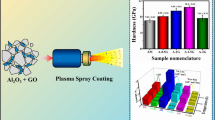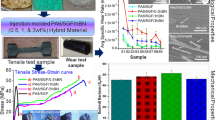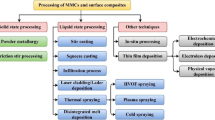Abstract
Solid-lubricant nanoparticles as additives in oil provide good tribological properties based on the physical lubrication mechanisms in the contact. For this reason, they are strong candidates for use in the lubrication of diamond-like carbon (DLC) coatings, which only poorly interact with the traditional, chemically based additives. In this study, we focused on how a tribofilm formed from MoS2 nanotubes is related to the tribological properties of these nanotubes, and then, we analysed such a tribofilm on steel and DLC-coated surfaces using scanning electron microscopy, energy-dispersive X-ray spectroscopy, X-ray photoelectron spectroscopy and Auger electron spectroscopy. We demonstrated that when using oil containing MoS2 nanoparticles, the formation of a tribofilm is a key factor in decreasing the friction for the steel and DLC-coated contacts. The major difference between the steel and the DLC contacts is the extent to which the MoS2-based tribofilm covers the surface, which is 20 % in the case of the DLC/DLC contacts, but almost 40 % in the case of the steel/steel contacts. Moreover, the MoS2-based tribofilm was found to be more oxidized on the DLC surface than on the steel surface. Nevertheless, we found that the chemical and functional properties of the MoS2-based tribofilm are very similar, or even the same, for both the steel and DLC-coated surfaces. No direct evidence of any chemical reactions between the MoS2 and the steel or DLC coating was observed.












Similar content being viewed by others
References
Roberts, E.W.: Thin solid lubricant films in space. Tribol. Int. 23, 95–104 (1990)
Singer, I.L.: Solid lubrication processes. In: Singer, I.L., Pollock, H.M. (eds.) Fundamentals of Friction: Macroscopic and Microscopic Processes, pp. 237–261. Kluwer Academic, Dordrecht (1992)
Martin, J.M., Donnet, C., Le Mogne, T., Epicier, T.: Superlubricity of molybdenum disulphide. Phys. Rev. B Condens. Matter Mater. Phys. 48, 10583–10586 (1993)
Singer, I.L.: Mechanics and chemistry of solids in sliding contact. Langmuir 12, 4486–4491 (1996)
Rapoport, L., Bilik, Y., Feldman, Y., Homyonfer, M., Cohen, S.R., Tenne, R.: Hollow nanoparticles of WS2 as potential solid-state lubricants. Nature 387, 791–793 (1997)
Greenberg, R., Halperin, G., Etsion, I., Tenne, R.: The effect of WS2 nanoparticles on friction reduction in various lubrication regimes. Tribol. Lett. 17, 179–186 (2004)
Joly-Pottuz, L., Dassenoy, F., Belin, M., Vacher, B., Martin, J.M., Fleischer, N.: Ultralow-friction and wear properties of IF-WS2 under boundary lubrication. Tribol. Lett. 18, 477–485 (2005)
Tannous, J., Dassenoy, F., Lahouij, I., Le Mogne, T., Vacher, T., Bruhács, A., Tremel, W.: Understanding the tribochemical mechanisms of IF-MoS2 nanoparticles under boundary lubrication. Tribol. Lett. 41, 55–64 (2011)
Kalin, M., Kogovšek, J., Remškar, M.: Mechanisms and improvements in the friction and wear behavior using MoS2 nanotubes as potential oil additives. Wear 280–281, 36–45 (2012)
Rapoport, L., Feldman, Y., Homyonfer, M., Cohen, H., Sloan, J., Hutchison, J.L., Tenne, R.: Inorganic fullerene-like material as additives to lubricants: structure–function relationship. Wear 225–229, 975–982 (1999)
Cizaire, L., Vacher, B., Le Mogne, T., Martin, J.M., Rapoport, L., Margolin, A., Tenne, R.: Mechanisms of ultra-low friction by hollow inorganic fullerene-like MoS2 nanoparticles. Surf. Coat. Technol. 160, 282–287 (2002)
Kalin, M., Kogovšek, J., Remškar, M.: Nanoparticles as novel lubricating additives in a green, physically based lubrication technology for DLC coatings. Wear 303, 480–485 (2013)
Golan, Y., Drummond, C., Homyonfer, M., Feldman, Y., Tenne, R., Israelachvili, J.: Microtribology and direct force measurement of WS2 nested fullerene-like nanostructures. Adv. Mater. 11, 934–937 (1999)
Kogovšek, J., Remškar, M., Mrzel, A., Kalin, M.: Influence of surface roughness and running-in on the lubrication of steel surfaces with oil containing MoS2 nanotubes in all lubrication regimes. Tribol. Int. 61, 40–47 (2013)
De Barros’ Bouchet, M.I., Martin, J.M., Le-Mogne, T., Vacher, B.: Boundary lubrication mechanisms of carbon coatings by MoDTC and ZDDP additives. Tribol. Int. 38, 257–264 (2005)
Kalin, M., Roman, E., Vižintin, J.: The effect of temperature on the tribological mechanisms and reactivity of hydrogenated, amorphous diamond-like carbon coatings under oil-lubricated conditions. Thin Solid Films 515, 3644–3652 (2007)
Equey, S., Roos, S., Mueller, U., Hauert, R., Spencer, N.D., Crockett, R.: Tribofilm formation from ZnDTP on diamond-like carbon. Wear 264, 316–321 (2008)
Kalin, M., Roman, E., Ožbolt, L., Vižintin, J.: Metal-doped (Ti, WC) diamond-like-carbon coatings: reactions with extreme-pressure oil additives under tribological and static conditions. Thin Solid Films 518, 4336–4344 (2010)
Kalin, M., Velkavrh, I., Vižintin, J.: Review of boundary lubrication mechanisms of DLC coatings used in mechanical applications. Meccanica 43, 623–637 (2008)
Kogovšek, J., Remškar, M., Kalin, M.: Lubrication of DLC-coated surfaces with MoS2 nanotubes in all lubrication regimes: surface roughness and running-in effects. Wear 303, 361–370 (2013)
Remškar, M., Mrzel, A., Viršek, M., Godec, M., Krause, M., Kolitsch, A., Singh, A., Seabaugh, A.: The MoS2 nanotubes with defect-controlled electric properties. Nanoscale Res. Lett. 6, 1–6 (2011)
Kogovšek, J., Kalin, M.: Various MoS2-, WS2- and C-based micro- and nano-particles in boundary lubrication. Tribol. Lett. 53, 585–597 (2014)
Wagner, C.D., Davis, L.E., Zeller, M.V., Taylor, J.A., Raymond, R.H., Gale, L.H.: Empirical atomic sensitivity factors for quantitative analysis by electron spectroscopy for chemical analysis. Surf. Interface Anal. 3, 211–225 (1981)
Seah, M.P., Clifford, C.A., Green, F.M., Gilmore, I.S.: An accurate semi-empirical equation for sputtering yields I: for argon ions. Surf. Interface Anal. 37, 444–458 (2005)
Seah, M.P.: An accurate semi-empirical equation for sputtering yields II: for neon, argon and xenon ions. Nucl. Instrum. Meth. B 229, 348–358 (2005)
Moulder, J.F., Stickle, W.F., Sobol, P.E., Bomben, K.D.: Handbook of X-ray Photoelectron Spectroscopy. Physical Electronics Division, Eden Prairie (1995)
Mattila, S., Leiro, J.A., Heinonen, M., Laiho, T.: Core level spectroscopy of MoS2. Surf. Sci. 600, 5168–5175 (2006)
Visic, B., Klanjsek Gunde, M., Kovac, J., Iskra, I., Jelenc, J., Remskar, M.: MoS2 nanotube exfoliation as new synthesis pathway to molybdenum blue. Mater. Res. Bull. 48, 802–806 (2012)
Kalin, M., Vižintin, J.: Real contact temperatures as the criteria for the reactivity of diamond-like carbon coatings with oil additives. Thin Solid Films 518, 2029–2036 (2010)
Kano, M., Yasuda, Y., Okamoto, Y., Mabuchi, Y., Hamada, T., Ueno, T., Ye, J., Konishi, S., Takeshima, S., Martin, J.M., De Barros Bouchet, M.I., Le Mogne, T.: Ultralow friction of DLC in presence of glycerol mono-oleate (GMO). Tribol. Lett. 18, 245–251 (2005)
Yang, M., Marino, M.J., Bojan, V.J., Eryilmaz, O.L., Erdemir, A., Kim, S.H.: Quantification of oxygenated species on diamond-like carbon (DLC) surface. Appl. Surf. Sci. 257, 7633–7638 (2011)
Acknowledgments
The authors would like to thank Mr. Janez Jelenc for the synthesis of the MoS2 nanotubes and the Slovenian Research Agency of the Republic of Slovenia for the financial support, Contracts Nos. J2-2115 and J1-2352. The authors would also like to thank Mr. Frederic Meunier from Sulzer Sorevi SAS (Limoges, France) for providing the DLC coatings.
Author information
Authors and Affiliations
Corresponding author
Rights and permissions
About this article
Cite this article
Kalin, M., Kogovšek, J., Kovač, J. et al. The Formation of Tribofilms of MoS2 Nanotubes on Steel and DLC-Coated Surfaces. Tribol Lett 55, 381–391 (2014). https://doi.org/10.1007/s11249-014-0366-4
Received:
Accepted:
Published:
Issue Date:
DOI: https://doi.org/10.1007/s11249-014-0366-4




